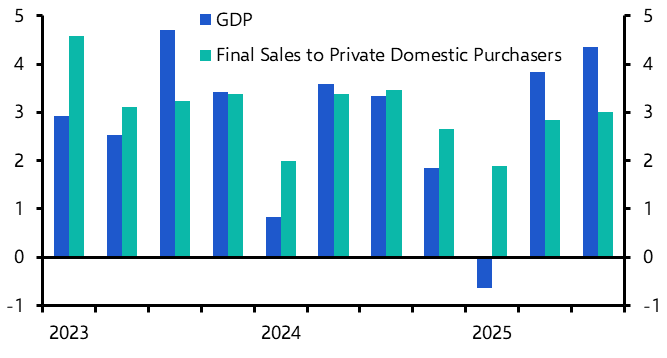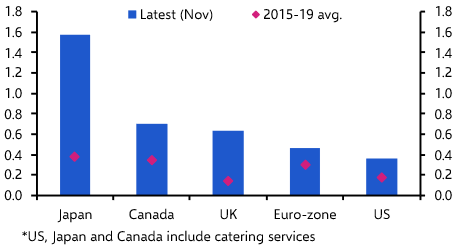Markets spent most of last week processing a dovish shift by two of the world’s major central banks. First came a speech by Mario Draghi, in which he gave the clearest indication yet that the ECB is preparing to launch another round of stimulus. This was followed by Wednesday’s FOMC meeting, in which US policymakers signalled interest rate cuts later this year. Bond yields duly fell and equity markets rallied.
You can read our take on both events here and here. I don’t propose to add anything in this note, other than to say that a) developments on the policy front are playing out broadly as we had anticipated and b) that the rally in equity markets looks overdone. At this stage of the cycle, monetary loosening by central banks will only generate a sustained pick-up in economic growth if it’s accompanied by an acceleration in productivity growth. In Europe, at least, this seems a distant prospect.
Mr Draghi’s comments came at the ECB’s annual forum on central banking at Sintra and was followed later in the week by a European Council meeting in Brussels. The unresolved structural problems at the heart of the euro-zone loomed heavily over both meetings – with all roads leading to Rome. The big debate among economists ahead of the Council meeting was whether Italy would be placed in an “Excessive Deficit Procedure”, or EDP. This is the disciplinary process that countries face if they break the EU’s borrowing limits. As things stand, it’s unclear whether Brussels will place Italy into an EDP or simply rebuke the government over its plans.
Stepping back however, any decision over whether to begin an EDP will be a political one. The economic reality is that Italy finds itself in a fiscal straightjacket.
The problem is not its fiscal balance – Italy has run a primary budget surplus in every year since 2011 and the government plans to continuing running primary surpluses in the years ahead. Rather the problem is one of debt accumulated through past borrowing combined with the economy’s extremely weak growth rate.
GDP growth is a critical component in the fiscal arithmetic since it generates the income needed to service debt. Between 1980 and the introduction of the euro in 1999 Italy’s economy grew by nearly 40% in real terms and more than quadrupled in current prices. But in the 20 years since the introduction of the euro it has grown by just 7.5% in real terms and 50% in current prices. The result is that, despite running sustained primary budget surpluses, Italy’s gross government debt/GDP ratio has continued to hover around 130% of GDP. This is dangerously high for a country whose central bank can’t stand behind the bond market.
There are four ways in which a country in Italy’s position could reduce its government debt ratio to safer levels: faster GDP growth, higher inflation, fiscal austerity or default/restructuring. As our Europe team argued in a recent piece, the first three of these routes are effectively closed off to Italy. This increases the likelihood of a resolution through a debt restructuring at some point. This could take several forms but, given Italy’s size, is likely to require utilising the balance sheet of fiscally stronger euro-zone countries, including Germany, either through some form of debt mutualisation or the creation of a “safe” euro-denominated asset backed by all member states.
This is unlikely to come to a head in the coming months and quarters. We’ve several instalments to go through before we reach an end game. But focussing on the narrow issue of the EDP, or whether Italy’s government might respond with a few tweaks to its spending plans to appease Brussels, risks missing the wood for the trees. The structural problems at the heart of the euro-zone run much deeper and resolving them will take takes years and perhaps decades. All of this strengthens the case for the additional policy support that Mr. Draghi hinted at last week – and suggests that it will need to remain in place for much longer than the markets currently anticipate.
In case you missed it:
(Requires login)
- Our Latin America Economist, Edward Glossop, argues that an Argentine debt default is more likely than not over the next few years.
- Our EM team explains why emerging market central banks don’t always follow the Fed.



